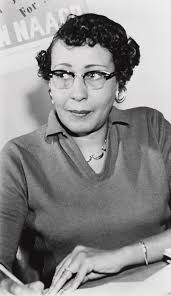1909 - 1980
By:
Denise Roper
|
Date Added:
Edited

Ruby Hurley is best known for her work as an administrator for the National Association for the Advancement of Colored People (NAACP), which began in 1939. During the 1950s and 1960s, she was an advocate for non-violence. Ruby was born and raised in Washington, D.C. By 1920, she was not being raised by her biological parents. Instead, she lived with a couple, Perey and Emma Ray. who were teachers.. She attended Dunbar High School, an academically enriched and predominantly African-American school in D.C. Many well educated instructors taught there. Ruby’s teacher was the son of former civil rights leader Frederick Douglass. In 1926, she graduated from high school. While employed by day, she attended evening law classes at Robert H. Terrell Law School. This school engaged in granting law degrees to African-Americans. It is notknown why she did not continue with her law studies. Nevertheless, she became discerning about the legislative process and this helped with her diverse career with the NAACP. In 1939, Ruby was *instrumental in interfering with the Daughters of the American Revolution (DAR). DAR cancelled *Marian Anderson’s concert appearance after learning that she was an African-American. Ruby, along with a committee of NAACP civil rights advocates, successfully arranged for the concert to move to the Lincoln Memorial, where it was held on April 9, 1939. *Onwards, she was an active member of the NAACP in her hometown. In *honor of her work with the organization, she was given the position National Youth Secretary in 1943. *As Youth Secretary, she expanded youth councils and college chapters,forming an additional 200 new *groups. She *greatly enhanced the organization’s membership*. *In total, NAACP youth groups incorporated 25,000 new members by the 1950s *due in large part to Ruby’s efforts*. She went to Birmingham, Alabama in 1951 for a recruitment assignment. She spent three months expanding membership in Alabama, Florida, Georgia, Mississippi, Tennessee and the Carolinas. Ruby was tasked with building ties within local NAACP branches and the NAACP main branch in New York City. She remained in this title until 1952. Ruby was diagnosed by a doctor with having situational stress disorder, after being a constant target for her civil right activities. Local authorities and residents paid attention to her activism. She received death threats, had bombs thrown at her home and got obscene phone calls. As a result, her health declined and she started losing weight. While in pursuit of working, which was often on the road, she did not always have enough money for food. She refused to eat at segregated restaurants. After an injunction on NAACP activities was passed in Alabama in June of 1956, the organization was banned from raising money and gaining new members. The state also hoped to gain the Southeast Regional ‘s membership list. This would have hurt their members. On that day, Ruby closed the branch and relocated to Atlanta, Georgia. She continued operating Southeast Regional operations from there. The court ruling lasted for eight years. On March 31, 1978, Ruby retired after 39 years of dedicated service for the NAACP. She was known as the “queen of civil rights" since she was one of few women to hold a top position in the NAACP. A position which was mainly reserved for African-American men.
click hereShare your thoughts on this story with us. Your comments will not be made public.
Email
Copyright ©2016 - Design By Bureau Blank